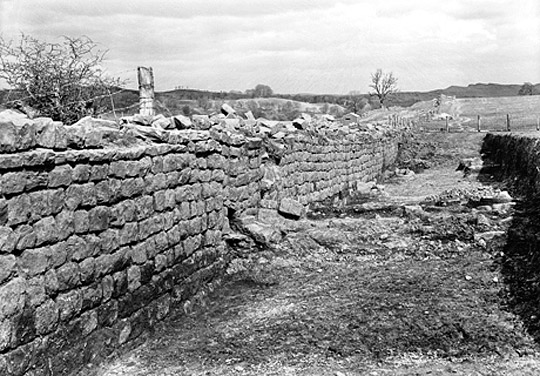Sources for Harrows Scar Milecastle and Wall
For a short and relatively unremarkable stretch of Hadrian’s Wall, a surprisingly large number of sources are available.

Material Sources and Collections
Finds from Ian Richmond’s excavations and the inscribed stones recovered during clearance are in the Tullie House Museum, Carlisle, together with the archives of the excavations. A 3rd-century pot decorated with a hunting scene would have been used to hold a variety of drinks.
The inscriptions found along the Wall are published in:
- Collingwood, RG and Wright, RP, The Roman Inscriptions of Britain, vol 1: Inscriptions on Stone (Oxford, 1965), nos 1868–71
- Tomlin, RSO, Wright, RP and Hassall, MWC, The Roman Inscriptions of Britain, vol 3: Inscriptions on Stone 1955–2006 (Oxford, 2009), nos 3415–38.
Each inscription has a number with the prefix RIB.
The single sculptured stone (showing Mars and Victory) is published in:
- Coulston, JC and Phillips, EJ (eds), Corpus Signorum Imperii Romani: Corpus of Sculpture of the Roman World – Great Britain, vol 1, fascicule 6: Hadrian’s Wall West of the North Tyne and Carlisle (Oxford, 1988), no. 75.
Visual Sources
There are few visual representations of this sector, largely because it was so recently exposed:
- James Irwin Coates, in his series of sepia paintings (dated 1879), shows the section of the Wall east of Harrows Scar overlooking the steep west bank of the river Irthing. This is reproduced in A Whitworth, ‘A 19th-century condition survey of Hadrian's Wall: the James Irwin Coates archive, 1877–1896’, in Hadrian’s Wall: Archaeological Research by English Heritage 1976–2000, ed T Wilmott (Swindon, 2009), 40, no. 132
- some pictures of the clearance work under Charles Anderson in the 1950s are reproduced in A Whitworth, ‘Charles Anderson and the consolidation of Hadrian’s Wall’, in Hadrian’s Wall: Archaeological Research by English Heritage 1976–2000, ed T Wilmott (Swindon, 2009), figs 174, 186–7.
Photographs in the Historic England Archive
Items in the Historic England Archive at Swindon relating to Harrows Scar and Hadrian’s Wall east of Birdoswald fort include:
- photographs of the Wall and Milecastle 49 taken in August 1929 by Father T Romans (AA71)
- a photograph taken by FG Simpson in 1938 entitled ‘The Weiring of the Scar – Hadrian’s Wall’ (P37167)
- an album of photographs of Hadrian’s Wall taken between 1934 and 1972, including some of Harrows Scar (AL0882)
- an album of photographs taken between 1948 and 1962, showing parts of the Wall near Harrows Scar in varying states of collapse (AL1212)
- prints of Charles Anderson’s photographs of conservation work on Hadrian’s Wall carried out between 1946 and 1974 (AND02). The negatives are held by the Vindolanda Museum.
More details of these and many other items can be found in the online catalogue. Some material is not yet listed in the online catalogue, including a large collection of aerial photography; for a full search, please contact the search team.
Copies of images and documents can be ordered through the website or by contacting the archive. For details of current charges for these services see the archive price list.
Published Secondary Sources
Excavation and Other Fieldwork Reports
Biggins, JA and Taylor, DJA, ‘A survey of the Roman fort and settlement at Birdoswald, Cumbria’, Britannia, 30 (1999), 91–110 [subscription required; accessed 21 March 2014]
Haverfield, F, ‘Report of the Cumberland Excavation Committee, 1895’, Transactions of the Cumberland and Westmorland Antiquarian and Archaeological Society, old series, 14 (1897), 185–91 [accessed 21 March 2014]
Haverfield, F, ‘Report of the Cumberland Excavation Committee, 1897’, Transactions of the Cumberland and Westmorland Antiquarian and Archaeological Society, old series, 15 (1898), 183 (accessed 21 March 2014)
Haverfield, F, ‘Report of the Cumberland Excavation Committee, 1898’, Transactions of the Cumberland and Westmorland Antiquarian and Archaeological Society, old series, 15 (1899), 345–64 [accessed 21 March 2014]
Hodgson, E, ‘Notes on the excavations on the line of the Roman Wall in Cumberland, in 1898’, Transactions of the Cumberland and Westmorland Antiquarian and Archaeological Society, old series, 15 (1899), 365–76 [accessed 21 March 2014]
Richmond, IA, ‘Excavations at Milecastle 49 (Harrows Scar)’, Transactions of the Cumberland and Westmorland Antiquarian and Archaeological Society, new series, 56 (1956), 18–27
Whitworth, A, ‘Charles Anderson and the consolidation of Hadrian’s Wall’, in Hadrian’s Wall: Archaeological Research by English Heritage 1976–2000, ed T Wilmott (Swindon, 2009), 61–2 [accessed 28 August 2013]
Later History
Graham, THB, The Barony of Gilsland; Lord William Howard’s Survey taken in 1603, Cumberland and Westmorland Antiquarian and Archaeological Society Extra Series 16 (Kendal, 1934)
Wilmott, T, ‘The late Roman transition at Birdoswald and on Hadrian’s Wall’, in The Late Roman Transition in the North, ed T Wilmott and P Wilson, British Archaeological Reports British Series 299 (Oxford, 2000), 13–24
Works Substantially Referencing the Site
Breeze, DJ, J Collingwood Bruce’s Handbook to the Roman Wall, 14th edn (Newcastle upon Tyne, 2006), 291–3
Wilmott, T, Birdoswald: Excavations of a Roman Fort on Hadrian’s Wall and its Successor Settlements: 1987–92, English Heritage Archaeological Report 14 (Swindon, 1997)
READ MORE ABOUT HARROWS SCAR MILECASTLE AND WALL